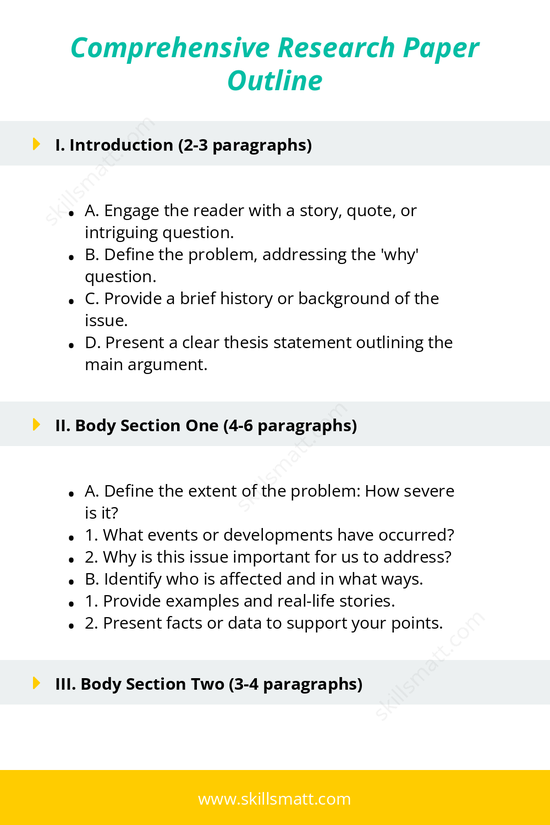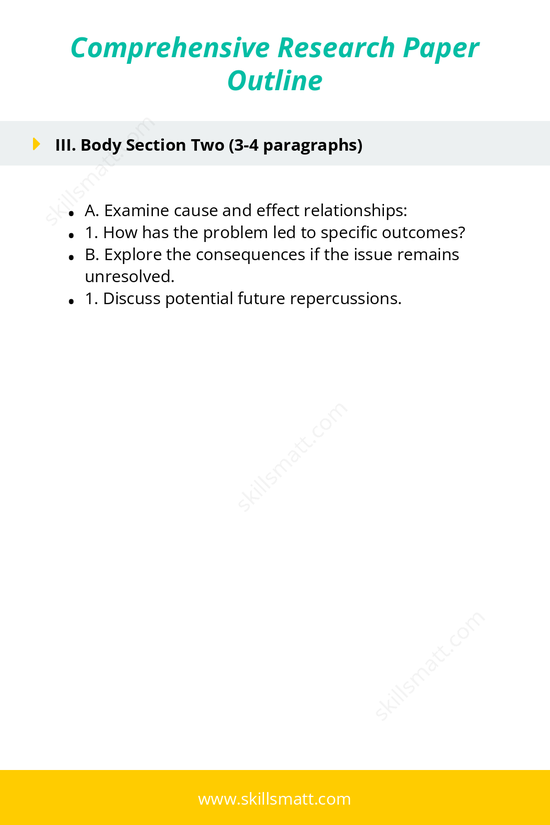Comprehensive Research Paper Outline
Creating a well-organized research paper outline is the first step toward writing a structured and focused paper. A comprehensive outline helps you break down your research into manageable parts, ensuring that your paper flows logically from introduction to conclusion. Below is a detailed guide to structuring a research paper.
I. Introduction (2-3 paragraphs)
- A. Engage the reader with a story, quote, or intriguing question: The introduction should capture the reader's attention. You can use an anecdote, a relevant quote, or a thought-provoking question that relates to your research topic.
- B. Define the problem, addressing the 'why' question: Explain the significance of the issue you are researching. Why is it important to study this problem? Why should the reader care?
- C. Provide a brief history or background of the issue: Give a succinct overview of the historical context or background information related to the topic. This provides the reader with necessary context and helps them understand the issue better.
- D. Present a clear thesis statement outlining the main argument: End the introduction with a clear, concise thesis statement. Your thesis should state your central argument or position and provide a roadmap for the paper.
II. Body Section One (4-6 paragraphs)
- A. Define the extent of the problem: How severe is it? Start by explaining how large or significant the problem is. Use statistics, facts, or research findings to showcase the extent of the issue.
- 1. What events or developments have occurred? Provide examples of key events or developments related to the issue that have contributed to its growth or significance.
- 2. Why is this issue important for us to address? Discuss the relevance of addressing this issue. Why should society, the government, or other stakeholders be concerned about it?
- B. Identify who is affected and in what ways: Clarify which groups or individuals are impacted by the issue. This could include specific populations, communities, or industries.
- 1. Provide examples and real-life stories: Use case studies, personal stories, or examples to make the problem relatable and tangible.
- 2. Present facts or data to support your points: Back up your claims with data, research, or expert opinions to solidify your argument and demonstrate the seriousness of the issue.
III. Body Section Two (3-4 paragraphs)
- A. Examine cause and effect relationships: Analyze how the problem has led to specific outcomes. What have been the consequences of this issue, both in the short and long term?
- 1. How has the problem led to specific outcomes? For example, explain how a lack of environmental regulation has led to increased pollution levels.
- B. Explore the consequences if the issue remains unresolved: What could happen if this problem is not addressed? Discuss the potential repercussions on society, the economy, or the environment.
- 1. Discuss potential future repercussions: Highlight possible future consequences or risks if the issue is ignored.
IV. Body Section Three (1-3 paragraphs)
- A. Propose possible solutions to the problem: In this section, suggest potential solutions that can help alleviate the issue. These solutions should be practical and actionable.
- 1. Discuss what solutions are most likely to work: Provide evidence or examples of solutions that have been successful in addressing similar issues.
- 2. Address solutions that are less effective: It’s also important to discuss solutions that may be less effective or have been shown to fail in addressing the problem.
- 3. Acknowledge possible objections or challenges to proposed solutions: Consider any challenges or objections that may arise with your proposed solutions. This shows you have thought critically about the issue and are prepared for counterarguments.
V. Conclusion (1-2 paragraphs)
- A. Tie back to the introduction, revisiting the story/quote/question: Connect the conclusion back to the opening, reinforcing the story, quote, or question you introduced. This creates a sense of closure and strengthens the impact of your argument.
- B. Restate the thesis in a compelling way and provide a final clincher to reinforce the argument: Conclude by restating your thesis in a fresh way, summarizing the main points, and offering a final thought or call to action that leaves a lasting impression on the reader.


